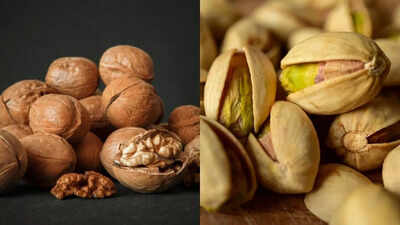Nuts are nutritional powerhouses, offering a satisfying blend of taste, satiety, and essential nutrients. When choosing between walnuts and pistachios, it's essential to understand their unique health benefits. Both nuts boast healthy fats, protein, vitamins, and minerals, but each has distinct advantages.

Both walnuts and pistachios contribute to overall well-being, supporting heart, brain, and gut health. While they share similarities, subtle differences exist. Understanding these nuances can guide you in selecting the nut – or combination – that best aligns with your dietary needs.
Here's a breakdown of the key nutritional differences between these two popular nuts:
Pistachios contain a higher protein content compared to walnuts.
Protein is crucial for muscle building and maintaining a feeling of fullness. If you're seeking a snack to curb hunger, pistachios are the superior option.
Walnuts stand out as the only nut with a substantial amount of plant-based omega-3 fatty acids, known as ALA.
Omega-3s are vital for cognitive function, focus, and memory. Walnuts are an excellent choice for students, seniors, or anyone aiming to enhance their brainpower.
Walnuts contribute healthy fats that aid in reducing blood pressure and inflammation.
Pistachios help lower "bad" LDL cholesterol levels due to their phytosterol content.
Incorporating both walnuts and pistachios into your diet is a smart approach to support cardiovascular health.
Pistachios offer a higher fiber content than walnuts.
Fiber promotes healthy digestion, supports gut health, and aids in blood sugar regulation. Pistachios may also foster the growth of beneficial bacteria in the gut.
Pistachios contain lutein and zeaxanthin, two antioxidants that safeguard eye health and help prevent age-related macular degeneration. Walnuts have limited amounts of these compounds.
Adding nuts to your daily meals is a simple way to boost both flavor and nutrition. Here's how to incorporate walnuts and pistachios into your diet:
Walnuts offer a mild, slightly bitter flavor and a satisfying crunch, making them a versatile addition to sweet and savory dishes.
Pistachios offer a slightly sweet flavor and vibrant green color. Eating them in the shell encourages mindful snacking and portion control.
Newer articles
Older articles
 Samsung Galaxy A35 5G and A55 5G: Full Pricing and Specs Revealed
Samsung Galaxy A35 5G and A55 5G: Full Pricing and Specs Revealed
 Warning Signs: 5 Clues Your Body May Be Signaling Prediabetes
Warning Signs: 5 Clues Your Body May Be Signaling Prediabetes
 SA20 Teams Allowed Up to Six Player Retentions, Enhanced by New RTM Card and Increased Salary Cap for Upcoming Auction
SA20 Teams Allowed Up to Six Player Retentions, Enhanced by New RTM Card and Increased Salary Cap for Upcoming Auction
 Brain's Eye View: Study Shows We See the World 15 Seconds in the Past
OR
The 15-Second Delay: How Your Brain Creates a Seamless, But Delayed, Reality
Brain's Eye View: Study Shows We See the World 15 Seconds in the Past
OR
The 15-Second Delay: How Your Brain Creates a Seamless, But Delayed, Reality
 Expert Tips to Help Kids Sharpen Focus and Combat Distractions
Expert Tips to Help Kids Sharpen Focus and Combat Distractions
 Cervical Cancer: Don't Ignore These 5 Subtle Warning Signs
Cervical Cancer: Don't Ignore These 5 Subtle Warning Signs
 Science-Backed: 5 Simple Daily Habits for a Healthier Heart
Science-Backed: 5 Simple Daily Habits for a Healthier Heart
 Shimron Hetmyer's Last-Gasp Six Stuns MI New York, Orcas Complete Record MLC Chase
Shimron Hetmyer's Last-Gasp Six Stuns MI New York, Orcas Complete Record MLC Chase
 Oral Cancer: Spotting the Signs, Understanding the Risks, and Why Early Detection is Critical
Oral Cancer: Spotting the Signs, Understanding the Risks, and Why Early Detection is Critical
 Infrequent Bowel Movements: When Is It Time to Worry? A Guide to Healthy Digestion
Infrequent Bowel Movements: When Is It Time to Worry? A Guide to Healthy Digestion